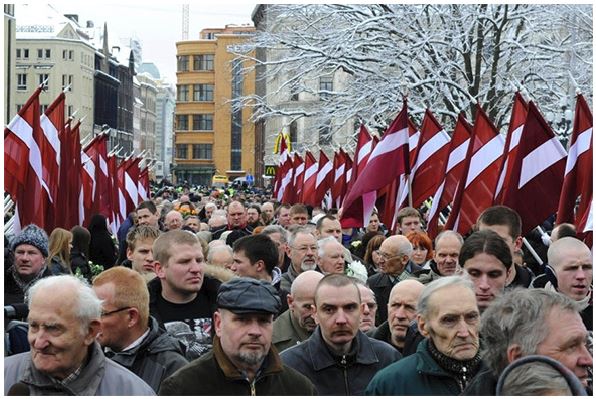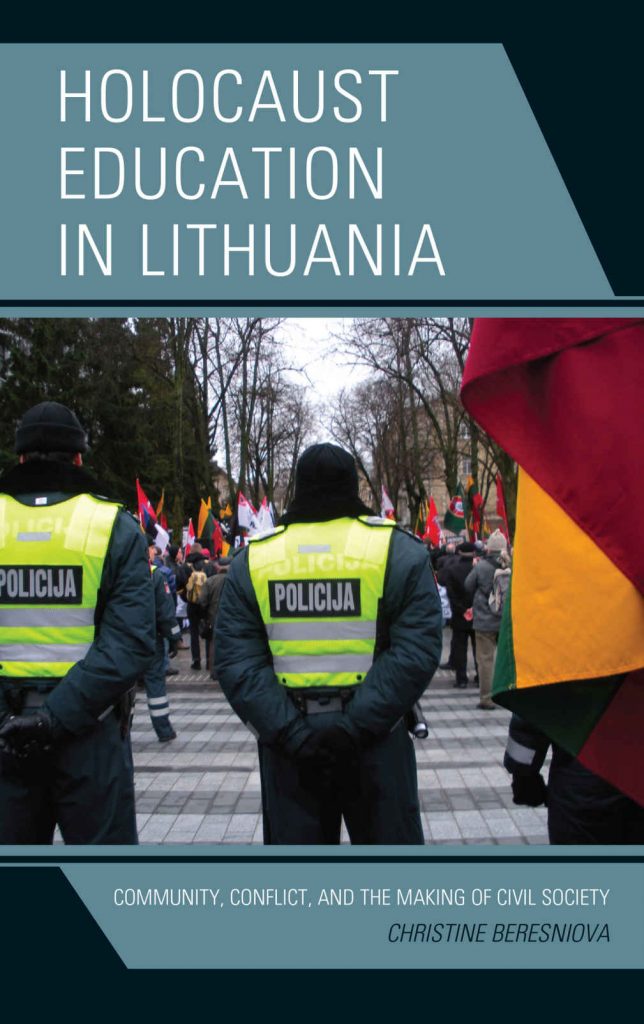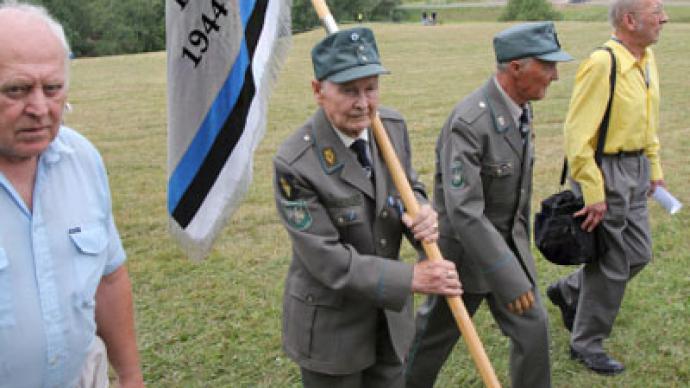
Views: 2970
On 23 June 2017 in the Parliament Square of Vilnius, capital of Lithuania, an official celebration of the uprising of 23 June 1943 against Soviet rule took place. The event was orchestrated mainly by veterans of the Lithuanian Freedom Fighters Association, a far-right militia group. During these celebrations an exhibit of more than 12 posters were hung which presented the anti-Soviet insurrection one that “drove terror into the Bolshevik occupying army and the lackeys of the occupation forces.”
Some historical context is needed here.
In June 1941, Hitler had launched a surprise attack on the Soviet Union, overrunning the Baltics in a few weeks. As documented by eyewitness testimony, photographs, and Nazi records, the Christian majority welcomed the Germans as liberators and right-wing paramilitary groups began massacring their Jewish neighbours before German rule had even been firmly established. Over the next three years of German occupation, around 200,000 Jews, more than 95 percent of Lithuania’s Jewish population, were murdered—a more complete destruction than befell any other European country. In an of inversion of Denmark, the nation where massive local resistance to the Nazi occupiers saved the lives of most Danish Jews, in Lithuania, zealous local collaboration ensured near-complete extermination. One of the only ways for a Jew to survive the Holocaust in Lithuania—the deadliest place on a deadly continent—was the way Yitzhak Arad, a Jewish anti-fascist did: as a partisan fighting the Nazis and their collaborators in the forests.
Thus the ‘lackeys’ (as referred to above) comprised the usual target for Nazi extermination policy: Jews, Russians, Communists, Gypsies or anybody who didn’t co-operate with the collaborationist Latvian pro-Nazi forces or the German Einsatzgruppen, Schutzstaffel (SS) paramilitary death squads, both of whom were responsible for mass killings. In one incident thousands of Jewish families desperate to avoid capture were forced back by the Lithuanian partisans, arrested by the Lithuanian Activist Front, held in concentration camps until were executed without trial at Kaunas VII Fort during June/July 1941
Episodes such as this represent a little cameo forming part of the history of Lithuania during WW2– a history is generally unknown outside of the West. Sadly, such events were not restricted to Lithuania, but were also a similarly squalid human rights record in Latvia and Estonia. Like the western Ukraine these were collaborationist states who were only too eager to welcome their German Nazi brethren.
 The situation in Latvia also followed the same pattern. Estimates suggest that approx. 75,000 Latvian Jews fell into Nazi hands. Moreover, even prior to the persecution of Latvian Jews by the German Nazi authorities, they had suffered anti-Semitic excesses at the hands of the Latvian militias. Chief among these were members of the Azsgargi para-military group and the fascist anti-Semitic organization – Perkonkrusts – which later collaborated with the Nazis in their annihilation of the Jewish community. During the October pogrom in Riga the Latvian Auxiliary Police, all the cities synagogues were destroyed, and 400 Jews were killed. According to German SS records some 38,000 Jews had been murdered by the end of December 1941.
The situation in Latvia also followed the same pattern. Estimates suggest that approx. 75,000 Latvian Jews fell into Nazi hands. Moreover, even prior to the persecution of Latvian Jews by the German Nazi authorities, they had suffered anti-Semitic excesses at the hands of the Latvian militias. Chief among these were members of the Azsgargi para-military group and the fascist anti-Semitic organization – Perkonkrusts – which later collaborated with the Nazis in their annihilation of the Jewish community. During the October pogrom in Riga the Latvian Auxiliary Police, all the cities synagogues were destroyed, and 400 Jews were killed. According to German SS records some 38,000 Jews had been murdered by the end of December 1941.
By the beginning of 1942 Jews were imported from German home and militarily occupied territories and incarcerated in various concentration camps – the most notorious being Salaspils and Kaiswerwald. Conditions were so bad that many died of disease and hunger.
It could be said that the German SS authorities to a large extent outsourced their Baltic holocaust to local collaborationist Latvian nationalists who undertook their allotted role with considerable alacrity.
Not to be outdone Estonia had its own mini-holocaust. Given that the original Jewish population of Estonia was much smaller than either Lithuania or Latvia the numbers of Jews murdered was correspondingly reduced. Nonetheless Units of the Eesti Omakaitse (Estonian Home Guard; approximately 1000 to 1200 men) were directly involved in criminal acts, taking part in the round-up of 200 Roma people and 950 Jews. Units of Estonian Auxiliary Police participated in the extermination of Jews in the Pskov region of Russia and provided guards for concentration camps for Jews and Soviet POWs.
Shameful! Barbaric! No, not a bit of it. Celebrations of indigenous neo-Nazi and SS reunions have been ongoing events in the Baltics since the collapse of the Soviet Union and the Baltic states’ integration into the EU/NATO bloc. (Well how could we leave such decent chaps outside NATO’s warm and protective embrace!?) In addition to the celebrations in Lithuania, there was earlier in the year – 16 March 2017- a march through the Latvian capital, Riga, in honour of the Latvian Waffen-SS Volunteer Legion [1]. International protests failed to prevent this event from taking place just as they failed earlier. Marches honouring the Latvian SS-men have been a regular event in Riga since 1990. In 1998, the Latvian government even went so far as to make that date a national holiday.
Suffice it to say that Russophobia is akin to a state religion in the Baltics (as is also the case in Poland and Ukraine). This is evident in both theory and practise. In a February 2012 referendum, Latvians roundly rejected Russian as an official second language. It is analogous to what happened in Ukraine after Yanukovich fled the country: The parliament overturned a law that would have granted official status to the Russian language. It was one of the post-revolution developments that seemed to alarm Moscow.
In Estonia, things are if anything even worse. Ethnic Russians are somewhere between one-fifth and one-quarter of the population. And yet, after Estonian independence in 1991, they were not given citizenship, even if they were born there. Russians who weren’t living in Estonia before Soviet times are given a grey passport connoting their official status as “aliens.” They can’t vote in national elections and have trouble finding work. To get citizenship, they must pass an Estonian language exam. (Estonian, which is not an Indo-European language but an Ugro-Finnic one, is notoriously difficult, with 14 cases.) The Language Inspectorate, which Russia Today derisively labelled “the language police,” performs spot checks on bureaucrats and teachers to make sure they know Estonian. If they fail the test, they lose their jobs. This is little more than a system of apartheid as was once evident in South Africa and is still the case in Palestine.
In the world of pop music there are so-called Tribute bands. Musical acts who appropriate and perform songs and sport other trappings from world famous groups. Thus, we have a Beatles tribute band, an Elton John tribute band…and so forth. In the case of the Baltics we have Tribute Nazism complete with songs, flags, symbols and the rest of the fascist bric-a-brac.
This being the political situation it should come as no surprise that the ethnic Russian population has fallen from 1,726,000 in 1989 to 1,052,520 this was the figure in the last consensus which took place in 2011. This raises further issues. Namely, the record of the Baltics’ membership of the EU. Whatever happened to the golden land of EU milk and honey and the promises held out to the Baltic populations by the EU? In short, they were sold – I can’t put it politely – a crock of shit. Economic and social conditions in the Baltic nations are among the worse in the whole Eurozone.
 The reality: The latest Eurostat report on the situation in Lithuania shows that up to 29% of the inhabitants are living on the verge of poverty, with the situation remaining unchanged for eight consecutive years. At the same time, Lithuania is among the top five states of the EU where people are being employed for meagre salaries.
The reality: The latest Eurostat report on the situation in Lithuania shows that up to 29% of the inhabitants are living on the verge of poverty, with the situation remaining unchanged for eight consecutive years. At the same time, Lithuania is among the top five states of the EU where people are being employed for meagre salaries.
The sad reality of this trend is evidenced by historical records showing an unprecedented drop in the population of Lithuania, that fell from the level of 3.7 million back in 1990 to 2.8 million in 2016, a drop of no less than 25%. Income inequality and the striking poverty of some Lithuanian residents is only getting worse over the years, putting Lithuania in the list of poorest EU states. The same inexorable population decline is also evident in Latvia. After obtaining independence from the Soviet bloc in 1991, the population of Latvia has been diminishing annually with the rate of 23,000 people a year. These frightening figures were unveiled last March by a professor of the University of Latvia, demographer Peteris Zvidriņš who would note that the sad reality is that Latvia loses some small town every two weeks.
In raw figures, that is 55 people a day, or 1,650 people a month. Another Latvian demographer, who heads a local office of the International Organization for Migration of the United Nations, Ilmar Mezhs, has recently told Skaties.lv that most of those who are leaving Latvia are not planning to go back. Referring to the forecasts of Eurostat, Mezhs suggested that in sixty years in the place of 2.7 million people who had previously resided in Latvia, one would find less than a million people still dwelling in this country. According to preliminary reports, the country’s population has already been reduced to 1.946 million people. Latvia has been plagued by high mortality rates along with the massive exodus of its people since 1991.
If this downward, demographic trajectory continues there is no possible future for these states, at least on present policies, since these policies are the problem. Any coherent national strategy would have to involve a break with the West and NATO/EU, a normalization of diplomacy and the establishment of trade links with Russia. But of course, this is completely taboo; Russia is the eternal enemy; the pervasiveness of this a pernicious dogma is comparable to heroin addiction, and is just as destructive. Such is the poisoned chalice of Russophobia. Sup it up and enjoy. It couldn’t happen to nicer people.
Reference:
[1] During WW2 some 150,000 thousand Latvians served on the side of the III Reich. The served in the so-called Volunteer Legion of the SS consisting of the 15th and 19th Grenadier Divisions of the SS (or first and second Latvian Divisions), the Latvia Luftwaffe Legion German Divisions and Police battalions. They were responsible for many war crimes.
Originally published 2017-10-28
Author: Frank Lee
Source: Off Guardian
Origins of images: Facebook, Twitter, Wikimedia, Wikipedia, Flickr, Google, Imageinjection, Public Domain & Pinterest.
Read our Disclaimer/Legal Statement!
Donate to Support Us
We would like to ask you to consider a small donation to help our team keep working. We accept no advertising and rely only on you, our readers, to keep us digging the truth on history, global politics, and international relations.
FOLLOW US ON OUR SOCIAL PLATFORMS










